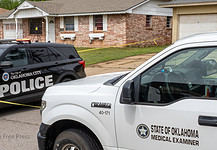Last Updated on October 19, 2019, 10:23 AM | Published: October 15, 2019
Public officials seemed relieved and buoyant when they revealed the new text message capability of the 911 emergency call system for central Oklahoma Monday.
The enhancements to the system will allow the deaf, hearing impaired and those who cannot talk to a dispatcher for any reason to text 911 operators in an emergency.
It marked the end of a development period and two weeks of testing before the service went system-wide.
To be sure
And, while texting may seem routine to most of us, those in charge of the rollout were not in any rush to get the enhancements in place for public use until they were fully tested and reliable.
“When it’s your worst day, we want that system to work 100% of the time,” said Brent Hawkinson, 911 and Safety Director of the Association of Central Oklahoma Governments (ACOG).
ACOG coordinates services between 49 different communities in central Oklahoma.
This roll-out is throughout the various 911 systems in the ACOG area that have had a close interoperable relationship previously.
Limitations
Jamie O’Leary*, Director for Oklahoma City 911 where the news conference was held, did identify limitations at the present.
“We are saying call if you can, text if you can’t,” said O’Leary. “Texts in our facility are limited to 160 characters. We cannot receive emojis. We do not receive videos or photographs at this time.”
“We do not have translations services via text,” she added.
However, O’Leary did encourage people to use their phones to capture photos and videos that may be helpful to law enforcement.
Hawkinson said that currently the technology is being developed for allowing photos and videos to be used but is not ready yet.
Slow development?
Free Press asked why their adoption of the service is seemingly slow compared to the widespread use of text messaging among the general public.
“Being an early adopter is not always the right answer, especially if we cannot provide seamless service,” said O’Leary.
She said that early in the testing process there were some “hiccups” in the system they had to work out before the system could go into full service.
“And so, rather than be an early adopter, we went through a very rigorous process with AT&T and ACOG for interoperability to make sure that when this went public it would operate well.”
Collaborative effort
“This has been a collaborative effort with Oklahoma City from the very beginning,” Hawkins said.
“We have always enjoyed the ability to transfer voice calls back and forth from our agencies to Oklahoma City and we know this texting capability had to be just the same. It had to be interoperable and it is.”
Hawkinson added, “We are currently on the leading edge of 911 systems, we just don’t want to be on the bleeding edge.”
“The citizens are depending on this and we have to get it right the first time, every time,” he said.
New connection
The addition of text services finally provides a real connection for the deaf and hearing-impaired who have had to rely on sometimes unreliable TTY services that some in that community don’t have access to.
The news conference Monday showed a culture of inclusion for those who have hearing or language barriers.
An interpreter signed the entire English-language part of the news conference and Major Paco Balderrama read a statement explaining the new features in the system in Spanish.
The entire news conference can be watched below.
*UPDATE: In the original version of this report we referred to Jamie O’Leary as “Janice O’Leary.” We are sorry for the mistake.
Founder, publisher, and editor of Oklahoma City Free Press. Brett continues to contribute reports and photography to this site as he runs the business.










